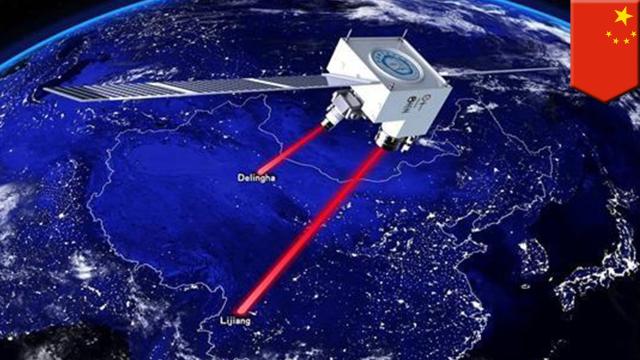A “quantum satellite” sounds at home in the James Bond franchise, but there really is a satellite named Micius with some truly quantum assignments. In this case, it helped the president of the Chinese Academy of Science make a video call. A quantum-safe video call.
Image: Screenshot/Youtube
The Micius satellite has made the news several times this year, thanks to its role in some crazy-sounding science such as setting quantum teleportation and entanglement records. The satellite is doing some potentially important real-life work, however, allowing the Chinese government to set up more secure communications lines with the help of quantum mechanics. Now, the Chinese Academy of Sciences reports the first quantum-safe video call between its president, Chunli Bai, and President Anton Zeilinger of the Austria Academy of Sciences in Vienna.
Essentially what’s going on to make this super safe call happen is rooted in the laws of quantum mechanics, entanglement and superposition. Individual particles act as both specks and waves simultaneously, with a list of possible properties. If you make these particles interact with one another, the mathematics of quantum mechanics requires that you describe them using the same equation — even if you separate them over large distances. If you entangle a pair of light particles and separate them, measuring one automatically implies what the other one should be.
This is often described as “spooky action at a distance”, but it isn’t really that spooky, especially considering how it was used here: To share encryption keys to ensure no one was eavesdropping on the call. Entangling photons over a long distance means that you share a link — but if there’s an eavesdropper on the communications line, then the laws of quantum mechanics causes these particles to lose their spooky connection. The scientists use this link to set up a secure line.
Basically, Micius sends entangled photons to two stations, one in Austria and the other into China, encoded with specific polarisations (the direction of the light wave’s wobble) as the security check. The scientists make measurements of the polarisations and then send back their measurement information, which the satellite reviews to ensure that there hasn’t been a collapse of the entanglement. It then creates the security keys, which the stations can use to encrypt and decrypt the data contained in the video call, according to an Austrian Academy of Sciences press release.
It’s sort of a single-use pad deal solely for the data in the video call, but generated via quantum mechanics.
So, again, no teleporting and nothing that crazy if you think about it, but the move is an important one symbolically. These quantum key distribution systems are meant to be unhackable if done right — though of course, there’s worry one could still find a way to hack such communications.
Anyway, the Micius satellite continues to plow ahead — and it might not be too long before you are sending journalists government document links with a quantum key.
